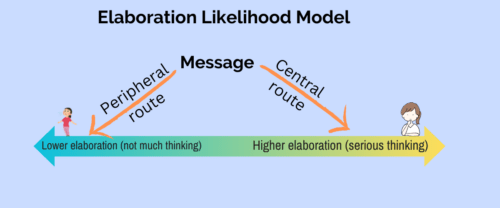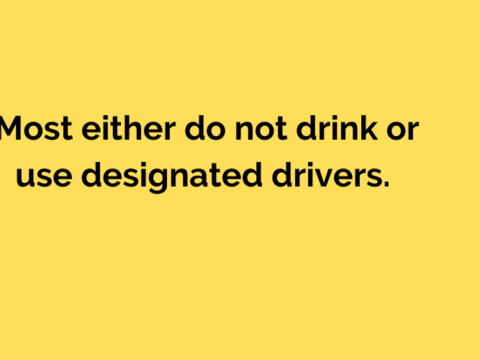Updated on May 20, 2024
This post explores how a US research team crafted anti-smoking messages using the Elaboration Likelihood model.
Below is one summary script of the twelve video clips the researchers showed to 1771 middle school students from Miami, Boston, and North Carolina school districts.
“With a fast-paced Latin rhythm, Juan mingles with the crowd in a schoolyard.
The narrator says,
“He’s cool because he wears the right gear, is a good student, nice to girls, cool with the guys, and, he doesn’t smoke”.
Then,
Juan refuses a cigarette and his friends comment; “he did the right thing”.
How did they respond to the message?
The researchers assessed student responses to a series of questions about the message quality on a 0-100 scale from not at all (0) to a lot (100).
The questions covered the following elements;
- The message had good facts.
- The message makes me think.
- The message looked cool.
- It was fun to watch.
The first two elements represented the central route of the Elaborated likelihood Model and the third and fourth represented its peripheral route.
What is the Elaboration Likelihood Model?
This tool helps us understand one of the ways our brain processes when we read a message. Our brain runs through two routes to understand a message. According to this model, persuasion occurs through these two routes.
- Central route
- Peripheral route.
What are these central and peripheral routes of persuasion?
The Central Route
The readers travel along the central route when they change their attitude by understanding the facts our message presents.
The Peripheral Route
On the other hand, the readers travel along the peripheral path when they change their attitudes not because of the facts the message presents but due to factors such as its emotional appeal and the person/s who appears in the message.
What influences readers when deciding the route: Motivation level and cognition level
As we can understand, according to this model, two reader elements influence what route the message recipient might travel to process the information presented: The motivation level and the cognition level. We can use several tactics to tailor our message to increase their motivation and suit the message to different cognition levels. However, the bottom line is that we should understand the audience’s demographic and psychographic elements.
In 1986, Petty and Cacioppo illustrated the above concepts.
How to increase the motivation level of message recipients
Richard Petty et al. describe several methods to increase message recipients’ motivation levels;
- Increase the number of peripheral cues in the message
- Increase the personal relevance of the message
- Making them feel personally responsible and accountable
- Making them feel that they are in the minority; however, it should be supported with facts and the social norms theory comes into play here.
How to increase engagement with those who have a lower ability to understand (lower need for cognition)
- Tailor the message’s argument to match the message recipients’ ability to understand. This is called “message tailoring”.
- Message repetition
- Adapting the message format; for example, the cartoon message format engages more message recipients with a lower ability to understand than the text-only format. On the other hand, the text-only format engages those with a higher ability to understand.
Elaboration Likelihood in a Continuum

Richard Petty et al. say that Elaboration Likelihood runs along a continuum. They suggest that many other theories of attitude change can roughly be placed along this continuum. For example, we can position the Theory of Reasoned Action at the higher end. At one end, we can put those at the lowest Elaboration Likelihood and the other end those at their higher Elaboration Likelihood. Some others can be in between depending on their motivation level and the ability to process the information presented in the message.
They use an example to explain this. If the HIV-related message source is a popular sports person, it will help those at the lower end of the Elaboration Likelihood to change their attitude. However, if the presenter has lived experience, it helps to cement their decision.
We need to remember, that the attitude changes by those who go through the central route are more resistant to counter-persuasive messages.
Does it matter?
Yes, it matters. Those who go through the Central Route are more determined to engage and continue in the desired behaviour than those who go through the peripheral route. However, we tend to change our attitudes and make decisions via the peripheral route.
Truth Initiative Anti-Smoking Campaign
How this campaign uses the model:
They use statistics and facts to appeal to individuals with high motivation and cognition while using celebrity endorsements and social media influencers to appeal to individuals with lower motivation and cognition.
Who developed it? and when?
Richard Petty and John Cacioppo developed in 1980.
Other dual-process models
The Elaboration Likelihood Model is a dual-process model. There is another such model; The Heuristic – Systematic model. Both models dominate in persuasion research. The common feature of both models is the reader invests some time to think about the message. Therefore, the message reader may change their attitudes after evaluating the arguments.
Narrative transportation as an alternative to the dual-process models
Some researchers propose the narrative transportation theory as a good alternative. The narratives can transport the reader temporarily into the narrative world created by the text; when the reader returns, they are likely to change their beliefs and attitudes.
More readings:
- An evaluation of television smoking prevention messages using the Elaboration Likelihood Model
- This article gives a very comprehensive account of the model.
- https://pdfs.semanticscholar.org/fa57/396ea5e169199dfdf4c54d247565239990b8.pdf
- Information processing through the elaboration likelihood model among young people.
- How an advertiser explores using the elaboration likelihood model
- Elaboration Likelihood Model.
- The Elaboration Likelihood Model for Website Design: This article explores how the model can be used to design our websites for persuasion.
- Elaboration Likelihood Model to evaluate two youth vaping prevention campaigns: “Real Cost” and The Truth” campaigns.
- Applying the elaboration likelihood model to explore vaccine Twitter messages




Leave a Reply